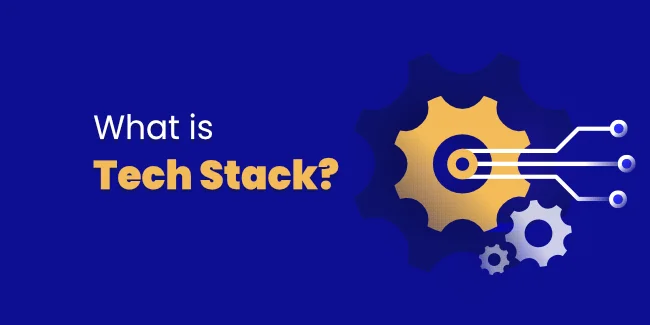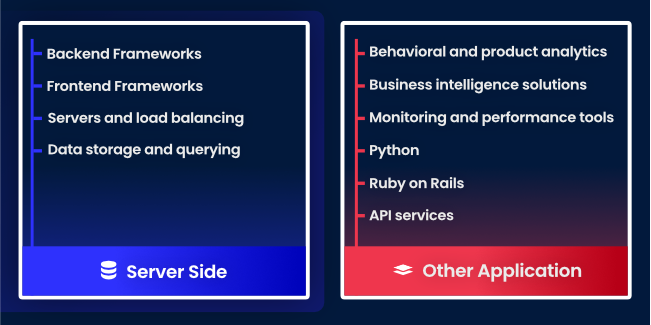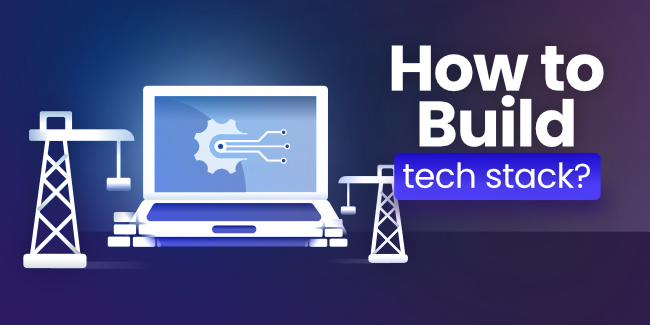What is Tech Stack?

A lot is going on behind the scenes when constructing a house. For various sections of the home, contractors use different building materials. Concrete, impregnated wood, clay, and sand are all used in the foundation. They utilize fiberglass, metal, or concrete tiles to keep heat and rain out as the first line of defense against heat and rain. To support the beams and walls, they incorporate recycled steel, wood, or brick masonry units (masonry blocks). A whole lot of different materials are used.
Like constructing a house, creating websites and mobile or web applications necessitates various "building components" and tools. These so-called technology stacks give software today its vitality. It influences the application's design, functionality, and future scalability. Here's an overview of the appropriate technology stacks for your startup team to utilize to increase their chances of developing software that users will enjoy.
What is a Tech Stack?
By definition, a tech stack is a company's combination of technologies for developing and operating an application, web app, or project. A "solutions stack" contains programming languages, frameworks, a database, front-end tools, back-end tools, and applications linked via APIs are all included in a solution stack.
The Categories of a Tech Stack

Before the rise of SaaS solutions and services, software development stacks were much more basic: they comprised of LAMP (Linux, Apache, MySQL, PHP), a previous standard for creating PHP-based web applications, as well as non-open source alternatives such as WAMP (for those who preferred Windows to Linux). Today, however, there are many technologies available to product teams and engineers to develop and maintain the right product for their market segment. While another firm is still gaining traction, it may choose low-cost, adaptable solutions they can swap out later. At the same time, another might select technology that scales well to serve corporate customers.
Here are the examples of primary groups and some of the most popular choices for each:
- Operating systems and programming languages – These will be determined by the sort of application you want to optimize for, as well as the environment in which you're most comfortable developing. Depending on how you want to build the backend and user experience and what devices are being produced for, you may wind up with many.
- Data storage and querying – This stack layer, which is responsible for storing and querying all of your real-time and historical data, consists of relational and non-relational databases, data warehouses, and data pipelines. These components are essential for keeping track of what goes on inside your app and how users interact. Later you may search this information to fine-tune your product.
- Servers and load balancing –This category includes servers, content distribution networks, routing, and caching services that allow your applications to send and receive requests, function properly, and scale as needed. The larger providers, like Amazon's and Google's, typically provide the same components as their smaller counterparts but allow you to purchase each service individually so you may combine them based on your product demands and preferred pricing structure.
- Frontend Frameworks – The services and frameworks you use to build the user experience, including the user interface and all the client-side functionality in your product.
- Backend Frameworks – It's a bundle of languages, libraries, and tools to assist
- assisting developers in creating apps. Frameworks include some of the fundamental capabilities you'll need to construct an app and structure for things like database management, user interaction, and sending out registration or password reset emails.
- API services – The applications that help you connect to the tools that make up your extended tech stack. Some API services are simply collections of thousands of pre-built APIs, while others are API gateways that help manage traffic when you need to send and receive large quantities of information from other systems.
- Ruby on Rails - A server-side web app developed with Ruby on Rails is easier to develop than one written in any other language. It enables the use of basic database architecture and website structures. Ruby on Rails works well with HTML, CSS, and JavaScript for creating user interfaces and JSON or XML for data transmission.
- Python - It's one of the most rapidly expanding languages. It's simple to utilize and is frequently studied in college introductory programming courses. It has a lot of modern and useful features. Python's popularity stems from its extensive use in data science and machine learning, among other things. Utilizing the popular Django web framework may also create internet applications.
- Monitoring and performance tools – A category of solutions that assist you in comprehending how each layer of your technology stack functions. Monitoring and performance tools gather and evaluate data about the technical performance of your software to monitor the health of servers, databases, services, and other internal systems.
- Business intelligence solutions – BI tools bring together data gathered from multiple parts of the company and the market and are designed to help track company performance and make higher-level business decisions. Many offer innovative ways to report on and visualize data.
- Behavioral and product analytics – A new but important category of technologies for monitoring, storing, and analyzing user behavior at every step of the customer journey. Some teams use analytics tools to analyze this data directly; other teams send it into data warehouses (some do both). The finest of these applications provide proactive insights and keep data tidy and organized.
How Important is it to Build your Tech Stack Right?

There is no such thing as a one-size-fits-all solution when it comes to your company's platform demands. Each business has distinct objectives, services, and obstacles. On the other hand, new apps and upgrades are being released every day, which is why we recommend monitoring your tech stack regularly.
Examine all of the tools your business requires to function effectively. It includes everything from the content management system that supports your website to the social media accounts you use to promote your brand. You may discover ways to save time and money by examining the apps your company utilizes, consolidating apps, maintaining a single source of truth for data, and so on.
Apps that your staff use should be linked to your company's strategic goals. Your company's demands will grow and change as it grows. You may not need some of the applications you used previously, or it may be time to invest in a new tool. However, as your list of apps grows longer, the law of diminishing returns applies, making it more challenging to maintain peak efficiency. It is when an audit might assist you in refreshing your toolkit.
A Couple of Tips and Tricks

The right technology stack can aid in the success of your product, making it easier to build and ensuring that it evolves with consumer demands. We interviewed product leaders who use behavioral and product analytics to understand better how consumers utilize their software. They make important decisions such as pricing, new feature prioritization, and marketing campaigns based on that knowledge. Here are some key tips we have prepared to make your tech stack more effective.
Make plans for the future
Preparing a tech stack for the future might be a double-edged weapon. If developers don't plan how their software will scale, they may add extra features that make maintenance difficult. On the other hand, if they expect exponential growth and invest too much in pricey technologies and services, they may run out of cash before the app ever achieves market success – or never does.
The ideal approach is to create minimal-viable products like web apps with open source technologies to experiment with before investing in them and to search for software that will allow you to send data to any of your other tools, even if it isn't essential initially.
Open source community is your friend
Open source community is created by a global group of developers whose aim is to reduce costs while increasing accessibility. Developers from all over the world collaborate to create free, accessible tools that anyone with an internet connection may use. The scope and usefulness of the open source community are remarkable.
Use analytics
Many developers require an understanding of the technology stack to manage it, so product analytics are popular. Analytics platforms combine data sources throughout the stack and provide detailed user tracking. It allows software engineers to find out what problems users have with their program, fix the issues, and debug them.
Consider the app's goal
Will the app be available on mobile or desktop? If it's a mobile application, will it be a native mobile app or a cross-platform one? What browsers will it require if it's a desktop application? Is it a news site that gets millions of visits each day or a banking software that must be safe? Various programming languages, tools, and tech stacks are suited to each purpose. Developers generally prefer languages they are already familiar with, but letting the application's objective choose its technology may pay off. Developers with the skills to complete the task might also be useful.
Conclusion
Having an optimized technology stack is critical for seeing positive and long-lasting results in your business. Your team may work more effectively than ever before with the appropriate tools and software, allowing you to develop faster. Don’t depend on popular technologies because they work for big and prominent companies. Weigh your options; consider all the pros and cons of your tech stacks. Remember, a wrong choice of technology stacks can end in a financial disaster.